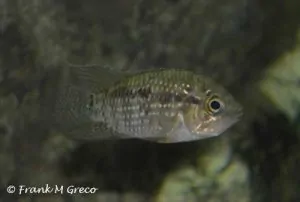Amphilophus supercilius
Supercilius is the Latin name for eyebrow. The authors refer to an over-proportioned part of the neurocranium (skull), which would give the fish a frowning expression. It seems like a somewhat sought-after name. In preliminary studies, the fish called Amphilophus sp. Barlow. Referring to George Barlow, the man who made the Midas complex his life’s work. Amphilophus barlowi (sic) would therefore have been an obvious choice, were it not for the fact that an Apistogramma was named after this researcher in 2008.
Description
Amphilophus supercilius has unique phenotypic features not found in other members of the Midas complex. In addition, they breed assortatively (only with their own species) and can be distinguished from other members of the complex already in the lake. Amphilophus supercilius is distinguished by its rounded caudal fin. In other members of the complex, the caudal fin is more triangular in shape. The rounder shape is caused by the smaller outer caudal fin rays. Unfortunately, we do not yet have permission to use the only existing photo of this fish (in live colors), hence the drawing.
When breeding, the fish has a dark gray to dark green ground color. Seven dark transverse bands, five of which are below the dorsal fin, plus a dark tail peduncle mark accentuate the body. Belly and chest are dark with a violet glow. Pectoral fins are yellowish-transparent. Belly, back, and anal fin grey-transparent. The posterior half of the caudal fin is slightly lighter and more translucent with a violet haze. Iris with gold rim. In that one photo of this fish, we see a specimen with a dorsal fin spot above the third transverse band (a characteristic that we also encountered in Amphilophus chancho). To what extent this says something about gender is not known.
Origin
Nicaragua
Distribution
Amphilophus supercilius is endemic to the crater lake Laguna de Apoyo. This is the largest and oldest (± 20,000 years) Nicaraguan crater lake and contains (so far) the largest number (6) of Midas Cichlid species. Amphilophus zaliosus, Amphilophus astorquii, Amphilophus chancho, Amphilophus globosus, Amphilophus supercilius and Amphilophus flaveolens. This number could increase even further in the coming years because the Nicaraguan crater lakes are currently in the spotlight. These young ecosystems are an excellent opportunity for evolutionary biologists to observe “evolution in progress”. However, haste is called for because human activities threaten the survival of these fledgling, vulnerable communities. The indirect result of all this interest is the new Midas species that have enriched our literature in recent years. Amphilophus supercilius is number five in Laguna de Apoyo.
The water in Lake Apoyo is clear and warm, it never falls below 27 degrees Celsius. The fish fauna is relatively poor. In addition to the Midas Cichlids, it contains Parachromis managuensis, the salmon Atherinella sardina, the viviparous Poecilia sphenops and the exotics Oreochromis niloticus and Gobiomorus dormitor. The lake contains almost no higher vegetation, at most some grassy species (Typha and Scirpus). However, in some places (from a depth of about 3 meters) the so-called “Chara beds”, or kelp fields, grow. Besides their chemical role of converting nitrogen and producing oxygen, these green meadows play a very important role in the community of Lake Apoyo. For example, they provide breeding grounds for Midas cichlids, a safe haven for small fish, and they form the favorite habitat for the snail Pyrgophorus coronatus, which is eaten by, among others. Amphilophus supercilius.
Unfortunately, tilapia (Oreochromis aureus and Oreochromis niloticus) escaped from fish farms, threatening the native fish population. The scope of negative consequences is almost incalculable. The disappearance of the said submerse Chara sp. (Characeae) for more than five years was clearly correlated with the introduction of these herbivorous Tilapias, but it has even been suggested that the outbreak of eye disease in the native Cichlids is due to these exotics. The latest fish descriptions, including that of A. supercilius, underline the importance of efforts to protect the Laguna de Apoyo Nature Reserve as a unique natural area and as a study site for sympatric speciation.
Behavior
Nothing is known about it.
Diet
Matthias Geiger (2008) calls the fish a “generalist” which means that what fits in it is eaten. He did this on the basis of a gastric examination. Quite diverse food components were found in it, such as fish remains, fish eggs, and snails, but also material of vegetable origin.
The Aquarium
A fish for pioneers. To us, there are no enthusiasts known to have cared for this fish in an aquarium. If there are future aquarists who gain experience with this species, please let us know!
Breeding
Little is known about reproduction. What the researchers noticed was that the fish has no preference for a certain depth. Most Midas breed at limited depths. Nests of A. supercilius, on the other hand, were randomly found between 2 and 20 meters in depth.
Author
Rene Beerlink – NVC
Copyright images
Rene Beerlink – NVC
Reference
Geiger M. et al. 2010. Description of two new species of the Midas cichlid complex from Lake Apoyo.
Literature
Geiger M. et al. 2010. Description of two new species of the Midas cichlid complex from Lake Apoyo.








Reviews
There are no reviews yet.